Laphria affinis Macquart, 1855:74.
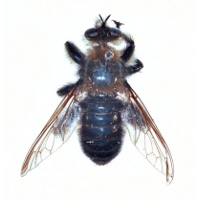 Male. Photo by S. W. Bullington |
Field shots at Herschel Raney's Robber Flies of Arkansas website Head in Profile This late summer and autumn species has the thorax covered with greenish- yellow pile. The front and middle legs have the femora and tibiae covered with dense yellow hair. The abdomen is black with black hair. The fly ranges in length from 15-24 mm. It is found throughout the southeastern United States. Along with several other eastern Laphria it resembles Bombus impatiens and Bombus (formerly Psithyrus) laboriosus, and is found within the ranges of these two bee species. |
Laphria apila (Bromley), 1951:22 (Bombomima).
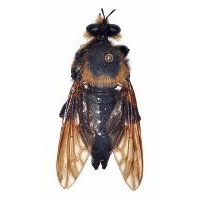 Male. Photo by S. W. Bullington |
Head in Profile
This species is one of our largest robber flies, ranging in body length from 28-35 mm. The male is also very distinctive. Its most outstanding characters concern the dorsum. The disk or center of the thoracic dorsum is covered with a thin layer of short, appressed golden pile, which appears black when viewed from above or behind, and the posteriolateral margins are fringed with long, appressed yellow hairs. The abdominal tergites are shining black medially, and fringed laterally with black hairs. Both characters are easily visible in the accompanying photograph. This monster is found in Alabama, Tennessee, and Georgia. |
Laphria champlainii (Walton), 1910:243-244, Plate IX (Dasyllis).
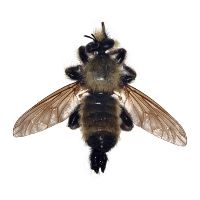 Male. Photo by S. W. Bullington |
Head in Profile
Ironically, in spite of the illustrated description by Walton, this is one species I have had considerable difficulty in recognizing. It can supposedly be distinguished from the other large species like L. grossa by having pale yellow hair both forming the tuft of hair in front of the wings and the tuft in front of the halteres. As Walton noted, the male terminalia also differ from those of L. grossa, in that the posterior margins of the basistyli in the two species have what Walton considered to be distinctively different outlines. I have not seen any authoratatively identified specimens of L champlainii; two that were standing under that name display a tuft of yellow hair in front of the halteres but have basistyli with margins differing both between themselves and from either L. champlainii or L. grossa; nor do they correspond in other respects to Walton's original description. For one, the coloration of their abdomen is completely different. Both are males, and both have yellow hair wholly covering tergites 2-4 of the abdomen, with black hair elsewhere, except for some scattered yellow hairs on tergite five. It is possible that part of the difference between this arrangement and what Walton observed is caused by a difference in age of the flies; in older specimens the hairs might fall off in a pre -determined arrangement ("male pattern baldness" in a fly?). For two, the tuft of hair in front of the wings is different, as noted below. Several specimens I have collected from Virginia are similar to these two. As luck would have it I have seen five specimens which, for reasons that will become clear, I am fairly certain are L. champlainii. Two of these are males, and three are females, and all are obviously the same species, being nearly replicas on one another in size and coloration. One of the males is labelled as a "metatopotype" and was collected on June 24, 1910 by H. B. Kirk. I have both it and the other four on loan from the USNM. The male in question was collected at Carlisle Junction, PA, the type locality for Dasyllis champlainii. It also matches Walton's description in almost every every respect, including the outline of the posterior margin of the basistylus. It's worth noting here that the tuft of hairs in front of the wings does indeed look yellow, but only when viewed from above; most of the hairs on the mesopleuae are black; as specified in Walton's description. In the two males I originally thought were L. champlainii, all these mesopleural hairs are yellow. The metatopotype male has replaced the one of those I had previously in the photograph to the left. BTW, I had previously mistaken these five "bona fide" L. champlainii specimens for L. huron. When I got them from the USNM they were standing under that name, were obviouly something other than the two males I then had reason to believe were L. champlainii, and were the only specimens from anywhere I could refer to L. huron. The other four specimens were a male collected at Wading River, NY, July 13, 1930, which was part of S. W. Bromley's collection; a female, also from Wading River, NY and Bromley's collection, but collected on July 12, 1930 and with "L.I." [presumably "Long Island] added on the label; a female, from Hyannis, Mass., collected on July 13, 1933 by W. Anderson; and last, a female just labelled as "N.C." The Hyannis female is the one in the accompanying photograph. The males can be further distinguished from L. grossa by the distribution of yellow hair on the tibiae--or second long "joint" of the legs. They have the posteriodoral surface of both the fore - and mid - tibiae bearing a strip of medium-length yellow hairs. In males of L. grossa these hairs are limited to the pro-tibiae. Bromley records the habitat as dry, sandy areas with scrub oak in the northeastern United States. |
Laphria cinerea (Back), 1904:289 (Dasyllis).
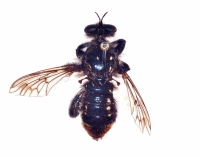 Male. Photo by S. W. Bullington |
Field shots at Herschel Raney's Robber Flies of Arkansas website Head in Profile This is one of the species with a pale colored tuft of hair in front of the wings, and pale hairs at the sides of the first abdominal segment. The pile on the thoracic dorsum is fine and sparse, and hairs and bristles on the scutellum are black. The pile on the sixth abdominal tergite is grayish or pale yellow. This is a small species, that ranges in length from 10-16 mm. It is found throughout our northeastern states. Habitat is logs and stumps in cut-over pine woods. |
Laphria divisor (Banks), 1917:54 (Dasyllis).
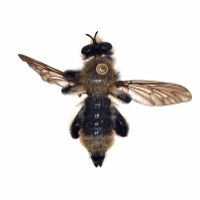 Male. Photo by S. W. Bullington |
Holotype (at MCZ) Field Shots (On-Site) Head in Profile This is another medium-sized northeastern Laphria. It ranges in length from 11-18 mm. In habits and general gesalt it is most likely to be confused with the sympatric L. flavicollis, but can be easily distinguished by noting the yellow pile near the tip of the abdomen. When in flight it strongly resembles a worker bald-faced hornet, Dolichovespula maculata. |
Laphria fattigi (Bromley), 1951:23-24 (Bombomima).
Laphria flavicollis Say, 1825:374-375.
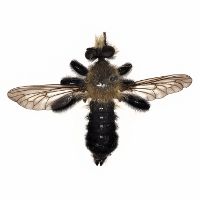 Male. Photo by S. W. Bullington |
Field Shots (On Site) Field shots at Herschel Raney's Robber Flies of Arkansas website Head in Profile This species ranges in length from 11-20 mm. It differs from the similarly- sized L. divisor in that the pile on the abdomen is all black. Adults can be seen in open woodland throughout most of the eastern United States. They usually sit on sunlit foliage, and bear a strong resemblance to the sand bee, Andrena carlini Cockerell. Franklin (1912) thought L. flavicollis resembled both the bumblebees Bombus impatiens and Psithyrus (now Bombus) laboriosus, with both of which it is sympatric. In my opinion this is only partially true, the resemblence only extending to small workers of B. impatiens; the queens of both this and B. laboriosus are much too large and although quick nowhere near as agile the fly. This is the only species of Laphria other than thoracica that regularly preys on honey bees. |
Laphria floridensis (Bromley), 1950:234 (Bombomima) [Manuscript name?].
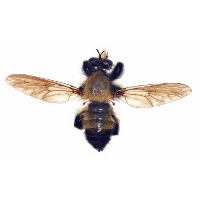 Male. Photo by S. W. Bullington |
Head in Profile
This name may not be valid, as Bromley did not manage to finish his formal description before his untimely death. Pobably for this reason it was not included in the names for Laphria in the 1965 Diptera Catalog. Never- the-less the species is distinct and well characterized, and is associated in print both with specimens and a photograph. I have therefore thought it wise to include it here. It is very similar to Laphria maquartii, but differs in having an predominantly yellow mystax, more yellow on the prothoracic tibiae, and yellow instead of black hairs on the dorsal side of the hind or mesothoracic femora, that is, on the first long "joint" of the hind legs. It also usually has only the first three rather than the first four abdominal tergites yellow. It ranges from 22-27 mm in length. As the name suggests, it is found in Florida. |
Laphria grossa (Fabricius), 1775:791 (Asilus).
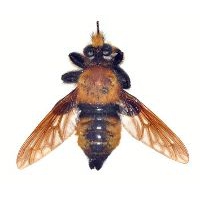 Male. Photo by S. W. Bullington |
Head in Profile
This is a very large robber fly. Adults range from 23-35 mm, and are bulky in proportion. The hair in the the tuft in front of the wings is black, and in the male there are no yellow hairs on either the mid- or hind- tibiae. The species is found from New England to South Carolina, with stragglers into Florida. Adults are partial to large stumps of elm and oak trees. They mimic the guest bumblebee Bombus (formerly Psythirus) laboriosus . They have been recorded as feeding heavily on Japanese beetles. I have seen two color forms of the female, but not enough specimens to say whether these represent different species or just extremes of normal variation. The first form is correlated with males of the typical, mimetic type referred to above. Both males and females of this form have the posterior portion of abdominal tergite two, all of tergites three and four, and the anteriolateral corners of tergite five covered with bright to dull yellow hair. The second form is based on several females from Illinois; they have bright yellow abdominal hair only on tergites two and three, and at the extreme anterior corners of four, with a fine coat of black hair elsewhere. I would be predisposed to think of these as going with the males of L. champlainii, were it not for the facts that they 1) are much larger, 2) have the tuft of hairs in front of the halteres jet black, 3) have the tuft of hairs in front of the wings at least partially black, and 4) differ in the coloration of abdominal segment four. The link to the left includes photographs of both forms. |
Laphria huron (Bromley), 1929:159 (Bombomima).
|
Field shots
at Herschel Raney's Robber Flies of Arkansas website As with Laphria affinis, the front and middle legs of this species have dense yellow hair on both the femora and tibiae. But in contrast to that species, the thorax has yellowish to brownish pile, and the normally black -haired abdomen occasionally has light hair intermixed on the second segment. Laphria huron is a medium-sized species, ranging from 15-20 mm in length. It is found from early- to mid- summer in Vermont, southern Canada, and, as its name suggests, the lake states. I have not seen this species. |
Laphria insignis (Banks), 1917:54 (Dasyllis).
|
Holotype (at MCZ) This is one of the species in which both the hair forming the tuft in front of the wings is mostly black and the hair on the scutellum is entirely black. The pile on the posterior portion of the mesonotum is reddish, and contrasts with the pile on the anterior portion, which is yellow. This is a fairly small species, only 13-18 mm in length. It is found in both eastern and western Canada (for details of its distribution in the West see notes in section on Western Laphria). I have not seen this species.
|
Laphria lata Macquart, 1850:379.
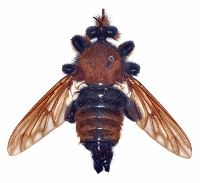 Male. Photo by S. W. Bullington |
Head in Profile
27-39 mm. This is our largest Laphria. It apparently differs from L. grossa only in the color of the hair, which varies from bright to dull yellow in that species is very dirty yellow to brownish yellow in L. lata. It is therefore likely that either I am mistaken in my identification, or the few specimens that have been identified as this species are melanic forms of L. grossa. If the latter, it is by no means certain that the two cannot interbreed. As with L. grossa the distribution of "light" hair on the abdomen of the female varies considerably. Currently the species is believed to be found from eastern Texas to Kansas east to Missouri and Illinois. |
Laphria macquarti (Banks), 1917:54-55 (Dasyllis).
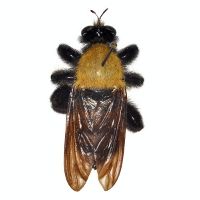 Male. Photo by S. W. Bullington |
Holotype (at MCZ) Field shots at Herschel Raney's Robber Flies of Arkansas website Head in Profile This magnificient species ranges from 22-27 mm, that is, it much the same size as L. grossa, L. lata, and L. apila. Like these species it is a probable mimic of the bumblebee Bombus americanorum, and might therefore be confused with these flies on that account. Both males and females can be distinguished from those of L. grossa and L. lata by having the middle or mesothoracic tibiae--the second of the long "joints" or sections of the leg--with a strip of long bright yellow hairs all along its upper or dorsal surface, that is, facing outwards. The male of L. apila also has this strip of yellow hairs, but here it is found on both the fore- and middle tibiae. Although you cannot see it in the photo of the male because of the folded wings, the first four abdominal segments are yellow- haired. The best way to distinguish this species from the closely-related but smaller L. floridensis is to look at the mystax. It is black in L. macquarti, and yellow, at least dorsally, in L. floridensis. You can also tell the species apart by looking at the vestiture of the hind femora; this is entirely black in L. maquarti, and yellow dorsally in L. floridensis. Laphria macquarti is found in Texas. Some exceptionally nice photographs of live specimens of this species can be found at this nature photography website by Greg Lasley. The distinctive tibial hairs are clearly visible in the photographs. |
Laphria nigella (Bromley), 1934:93 (Bombomima).
|
This species was described from a single male taken in Austin, Texas on May 21, 1921 by R. H. Painter. According to the description, the vestiture of the head and of all three tibiae is completely black. I have not seen this species.
|
Laphria posticata posticata Say, 1825:374.
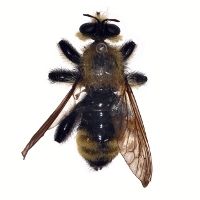 Male. Photo by S. W. Bullington |
Field Shots (On Site) Field shots at Herschel Raney's Robber Flies of Arkansas website Head in Profile This subspecies is one of three described "varieties" under the name L. posticata, the other two being L. posticata brunnea and L. posticata scutellaris. These latter were described as Bombomima by Bromley in 1929. In keeping with the modern (and perhaps unfortunate) tendency to ignore varietal distinctions, Bromley's two names were listed as synonyms of L. posticata in the 1965 Diptera Catalog. I have seen specimens of L. posticata scutellaris, and they are very distinct from the nominate subspecies--so much so, in fact, that I would not hesitate to upgrade them to full specific status. I have therefore added a separate synopsis for this subspecies below. As for L. posticata brunnea, for now I will reserve judgement, but from the description it sounds more like a melanic form than something truly distinct. And as if this situation weren't complicated enough already, Bromley speculated in this 1934 Ph.D. dissertation that the species probably hybridized with the more southern L. virginica. I believe he was correct. I personally have seen a male L. posticata posticata pinned over a female L. virginica, presumably indicating that they captured while in copula. Whether the progeny from such a union could ever develop, or, if it did, what sort of adult would be formed, is unclear. The nominate subspecies is found in the United States from New England west to Minnesota, and across northern Canada perhaps to Alaska (see the notes in the section on Western Laphria.) It has the pile on abdominal tergites 4-5 all yellow, and on 6-7 all black. It is found in early summer, and ranges from 12-18 mm in body length. It resembles the bumblebee Bombus fervidus, with which it is sympatric. Adults have been reared from larvae collected in white pine stumps. The redescription below refers only to this subspecies. |
Laphria posticata scutellaris (Bromley), 1929:159-160 (Bombomima).
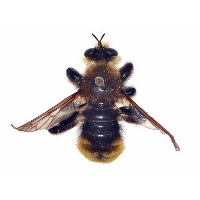 Male. Photo by S. W. Bullington |
Field Shots (On-Site) Head in Profile This subspecies can be distinguished from L. posticata posticata most easily by looking at the color of the hairs on the margin of the scutellum, on the dorsal surface of the hind tibiae, and on tergite 6 of the abdomen. These hairs are all black in the nominate subspecies and yellow or golden-yellow in this one. The first and third of these may seem like trivial differences, until one considers that 1) the color of the scutellar hairs has been widely used in conjunction with other characters to differentiate species, and 2) the color of the tergal hairs alone separates the nominate subspecies from all of its conspecifics in the West. Further, not one of the three character states in L. posticata scutellaris is intermediate between L. posticata posticata and the one species with which it is suspected to occasionally interbreed, namely, L. virginica. The latter has black scutellar hairs, black tibial hairs, and an all-black abdomen. I have only seen two specimens of L. posticata scutellaris, one from the original paratype series from Ontario, and one from Michigan. This latter specimen differs slightly in the abdominal coloration. |
Laphria royalensis (Bromley), 1950:1-3 (Bombomima).
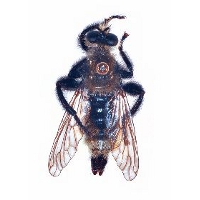 Male. Photo by S. W. Bullington |
Head in Profile
This species was described from a number of specimens taken in Michigan. The original series came from Isle Royale on Lake Superior, hence the name. The fly itself is 10-15 mm long, and, as can be seen from the photograph, the males are somewhat lightly built. This species most resembles Laphria insignis, but differs in that the posterior portion of the mesonotum is not covered with a distinct layer of red pile as in that species. L. royalensis differs from the very similar L. posticata in the structure of the basistyli. The posterior margin of each basistylus is "notched" in the former species whereas in the latter it is not. |
Laphria sacrator Walker, 1849:382.
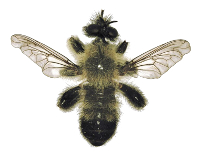 Male. Photo by S. W. Bullington |
Field shots at Herschel Raney's Robber Flies of Arkansas website Head in Profile The 1965 Diptera Catalog records this species from Wisconsin to Quebec and South to Connecticut. It is even found in western Pennsylvania; I have collected a male in a Malaise trap in my yard in DuBois. There are a fair number of specimens standing under the name in various museums. Two of these are pictured in the photos. This is one of the several species that are famous for being a bumblebee mimic. It resembles the bumblebees Bombus vagans and B. perplexus and is found within the ranges of these two species. It was featured in a chapter, "The Bumblebee's Mimic" in Hancock's 1911 book Nature Sketches in Temperate America. There, the model was stated to be Bombus consimilis. Hancock's observations were made at Lakeside, Berrien County, Michigan. |
Laphria saffrana Fabricius, 1805:160.
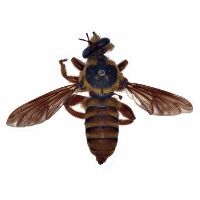 Male. Photo by S. W. Bullington |
Field Shots (On Site) Field shots at Herschel Raney's Robber Flies of Arkansas website Head in Profile This species has the body covered predominately with short, appressed, saffron- yellow hairs. The mesonotal disk also has a pattern of black and yellow. The fly ranges from 16-25 mm in length. Distribution is limited to the coastal plain of the southeastern United States. Habitat is open pine woods near logs or stumps. It is an excellent mimic of the wasp Vespula squamosa. A photo comparing the two is is given in the Laphria s. str. introductory page. Unlike other members of the genus L. saffrana often lands directly on the ground. |
Laphria thoracica Fabricius, 1805:158.
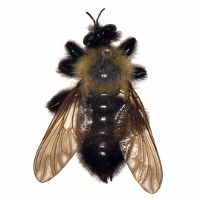 Male. Photo by S. W. Bullington |
Field Shots (On Site) Field shots at Herschel Raney's Robber Flies of Arkansas website Head in Profile This species is probably the commonest of all northeastern Laphria. It is an excellent mimic of the sympatric bumble bees Bombus impatiens, B. vagans, and B. (formerly Psithyrus) laboriosus, and when in flight cannot be distinguished from its models even at close range. A comparison of this species with another cuckoo bee, Bombus (formerly Psithyrus) citrinus is given in the Laphria s. str. introductory page. This species often haunts apiaries, and is the "bumble bee" bee keepers see making off with their bees. The color of the abdomen varies greatly, ranging from completely black to mostly yellow. It is likely that at least some of these variants represent undescribed species. However, despite the huge number of specimens in most collections, no one has ever taken the time to compare the geographic distribution of the various forms, to look for correlated, consistent differences in the terminalia of the males, or even to do the obvious studies of controlled mating and rearing. Adults have been reared from larvae collected from galleries in a chestnut tree, from a hollow apple tree, and from the stump of a tulip tree. The latter were described by Greene (1918). |
Laphria virginica (Banks), 1917:53-54 (Dasyllis).
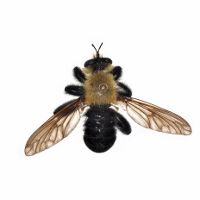 Male. Photo by S. W. Bullington |
Syntype (at MCZ) Head in Profile This species is easily recognizable by its stout form, medium size, and the contrasting solid yellow of its thoracic dorsum and solid black of its abdominal tergites. It ranges from 13-20 mm in length and is found in sandy locations along the Atlantic seabord. Supposedly it perfers to land on stumps of hard pines, such as pitch and short leaf. It is a good mimic of a worker of the bumblebee Bombus impatiens. |
Laphria vorax (Bromley), 1929:158 (Bombomima).
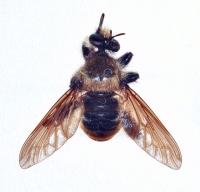 Male. Photo by S. W. Bullington |
Field shots at Herschel Raney's Robber Flies of Arkansas website Head in Profile 20 mm. This is another "odd-ball" Laphria, coming as it does from Iowa, Nebraska, Kansas, Arkansas, and Oklahoma. To me, it very much resembles L. huron, although Bromley, who described both species, claims it is most similar to the western L. fernaldi (which he may have used as a sort of "standard" for comparing western types). It can be easily distinguished from L. fernaldi by looking at the sixth abdominal tergite. In L. vorax this tergite bears only black hairs, whereas in L. fernaldi it is clothed with yellow ones. Further, the two species are never found together. Laphria vorax can be distinguished from L. huron by noting the distribution of yellow pile on tergite 5 of the abdomen; in L. vorax , this hair entirely covers the tergite, whereas in L. huron, it is limited to the anterior and lateral margins. The distribution of Laphria vorax in the Great Plains was profiled in the following technical note: Warriner, M. D. 2007. Notes on the distribution of the robber fly, Laphria vorax. The Prairie Naturalist 39(3,4): 171-175. (This is a 232 KB "pdf" file. The link is to the Arkansas Natural Heritage Commission, where Warriner has posted a copy for download; a local copy can be accessed here.) Warriner examined specimens of L. vorax from Arkansas, Iowa, Kansas, and Nebraska. |